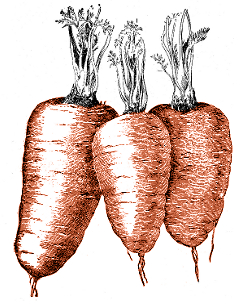Archive for the ‘Decorative’ category
Posted in Decorative, The Old Garden In Bristol on Thursday, October 1st 2020 (7.12 PM).
It’s been a few years now since we deliberately planted any nasturtiums, other than occasionally moving seedlings that have been popping up in particularly strange places. Since then, they’ve been left to self-seed. Every year, midway through summer we start thinking “there aren’t many nasturtiums this year,” and then when they come up, “the nasturtiums aren’t flowering much this year”, because we forget how late in the season they really come into their own.
This year was no exception. By the end of August we had plenty of foliage but barely a single flower; in mid-September we noticed they had suddenly leapt up and were climbing all over the back neighbour’s shed roof; and now, at the start of October, they have taken over half the back bed and are covered in flowers.

Their long, muscular stems are bursting through the honeysuckle, across the lemon balm and around the rosemary, and wide, round leaves are bursting through all over the place.
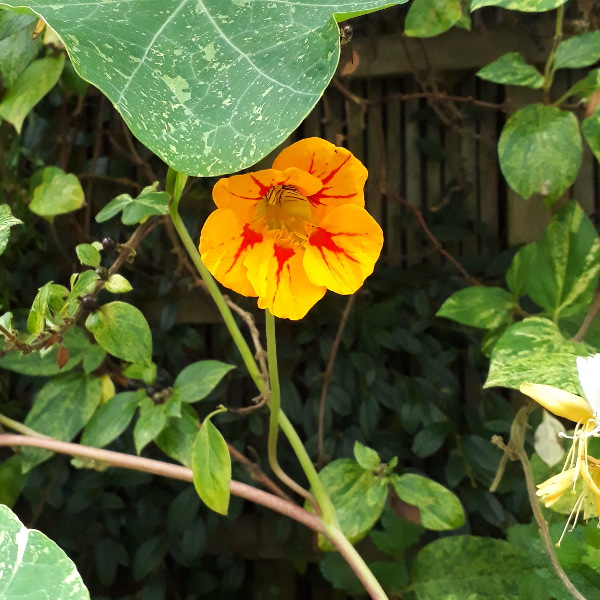
nasturtium, Tropaeolum
Posted in Decorative, Experimentation, Garden Diary, Inspiration, The Old Garden In Bristol on Tuesday, April 26th 2016 (9.46 PM).
A few years ago, now, we spent a couple of weeks one September on a camping trip to the Mittelrhein region of Germany. We spent those weeks driving around various towns and cities: Koblenz, Köln, Mainz, Bonn, countless smaller towns with a town wall, four gates, gingerbread architecture and a castle overlooking it all. Towards the south of the area we visited every valley was covered in vineyards; but further north, where the land flattened out towards the spires of Köln cathedral, we drove along surrounded by pumpkins and squashes ready for harvest.
Up in the Eifel hills, west of Koblenz and Andernach, we visited the Benedictine abbey of Maria Laach, tucked away inside the crater of a beautiful, placid, dormant volcano. In the abbey’s shop we bought two souvenirs: a bottle of the roughest cider I’ve ever tasted outside Somerset, and a packet of ornamental squash seeds, a variety of Curcubita pepo called “Schwanenhals”, or “Swan-neck”. In our tent we drank the cider and grimaced; and when we got home, the packets of seeds went into the seed tin. No doubt to German gardeners they are just a regular brand of seeds from the local garden centre, but to us they were something of a holiday souvenir.
We never actually planted them, though, but the other week when working out what we could grow within our new set of gardening tenets, and as I was going through my seed tin working out what might be salvageable and workable within those guidelines, I came across the Zierkürbis packet. The seeds are obviously well past their recommended sowing date, but the longer they were left on the shelf the less viable they would always be in any case. So today, all 9 seeds in the packet went into fibre pots on the windowsill; the hope being that, should any sprout, they will be large enough to be transferred outside right at the ideal time of year.
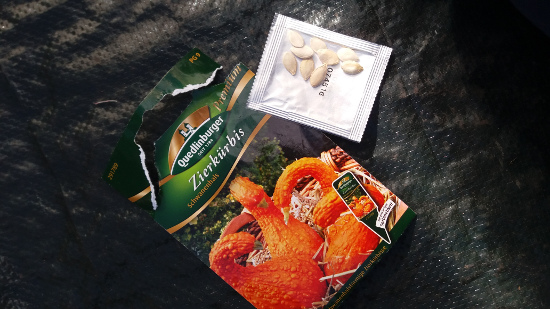
It will, of course, be slightly disappointing if nothing comes up; but better than never knowing at all.
squash, zierkürbis
Posted in Decorative, Experimentation, Garden Diary, Practicalities, The Old Garden In Bristol on Sunday, April 17th 2016 (9.18 PM).
This afternoon, I finished weeding the rosebay willowherb, until more shoots spring up at least. Weeded every shoot I could see, dug up every rhizome I could find, levelled out the soil and spread a layer of compost across the top.
The sowing plan for the bed starts with: peas at the back, against the trellis. Now, I’ve had issues with pea support in the past, and I suspected that the laths of the trellis are a bit big for a pea plant to wrap a tendril around, so the trellis has been covered in green plastic pea netting. It’s not the prettiest solution but it’s not too obtrusive; and I’m sure the vines of the back neighbour’s honeysuckle will love clinging onto it too.
In the front of the bed, we have scattered various seeds, mostly flowers, in the hope that the will grow up in front of the pea plants without eclipsing them entirely. We’ve scattered handfuls of:
- Cornflower, Centaurea cyanoides “Blue Diadem”
- Night scented stocks, Matthiola bicornis
- Corn marigold, Chrysanthemum segetum
- Poppy, Papaver rhoeas “Flanders”
- Swiss chard, Beta vulgaris vulgaris Cicla-Group “Five Colour Silverbeet”, because Gretchen has spotted it elsewhere and liked the different colours of the leaves.
- Tree spinach, Chenopodium giganticum “Magenta Spreen”, scattered from a packet I bought a couple of years ago and intended to sow but never did. The aim of the tree spinach is much as it was when I bought the packet: it has been sowed in the left-hand end of the bed, a dark and fairly damp corner where not much grows apart from dandelions. Tree spinach might prefer sun, but will hopefully cope with the shade there; and there won’t be any peas at that end that it might crowd out.
There are also nasturtiums, Tropaeolum majus “Empress of India”, apparently “a classic Victorian variety” according to the Internet, sowed in a couple of spots, their seeds like tiny miniature brains. The key to all of this, of course, is the idea that the peas are going to clamber up high enough and quick enough that none of the stuff around them will cause any problems. The other key, which you might have realised, is that nearly all of the ornamental (or semi-ornamental) stuff is self-seeding. Hopefully, once everything is set up, everything will keep on going year after year, or at least until we move house.
This is all very experimental and no doubt a Proper Gardener would tell us we were trying to cram far too many plants into a tiny space. However, we will wait and see. I won’t be surprised if not everything develops, or at least, doesn’t grow exactly how I originally envisaged things. It might need a bit of tweaking next year, or it might all come up again, irregular but satisfactory.
I’ve given up on the calendula seeds mentioned previously, and bought a new packet. Into pots, we sowed:
- More calendula, obviously.
- And more Tropaeolum majus.
- Mixed rocket leaves
- A different dwarf sunflower, Helianthus annuus “Choco Sun”, allegedly one of the smallest sunflower varieties available. Short enough for a toddler to sniff, I hope.
And with a general tidy-up, the garden is looking reasonable again. The back bed may be bare soil now, but hopefully within a month or two it will be full of greenery, and mostly the greenery we intended, too. In the tidy-up a lot of the wooden containers were thrown away, their wood rotted too far to save them, but that leaves us a good terracotta core. The plants we bought and potted up 2½ weeks ago are settling in nicely: the fennel looking lively, the thymes putting on new growth, and the marjoram already starting to fill up its pot. I’m rather pleased with how quickly things have been turned around. Even if things aren’t perfect yet, there’s not too much more tidying up left to do.
calendula, chard, corn marigold, cornflower, creeping thyme, fennel, french marjoram, green fennel, lemon thyme, marigold, marjoram, nasturtium, pea, poppy, rosebay willowherb, sowing, sowing plan, sunflower, swiss chard, thyme, tree spinach, weeding, Tropaeolum
Posted in Children, Decorative, Experimentation, Garden Diary, The Old Garden In Bristol on Monday, April 4th 2016 (10.36 PM).
The gardening was certainly a hit with the children: the first thing they wanted to tell the child-minder the next time they went to see her. Indeed, most days since then they have asked, at some point, to help in the garden. They now have a small watering can. The watering can may have been a mistake. They like watering, maybe a bit too much. For The Child Who Likes Animals, their watering can just isn’t enough: he has to grab hold of the big watering can and take charge of that. The Child Who Likes Fairies is happy with the small one, but every time it’s empty there is a cry of “More water!”
We have acquired and re-potted another new plant from the garden centre: a lavender, Lavandula x intermedia “Vera”. A small one-litre plant at the moment, we’ve put it into a wide plastic thing in the hope that it will grow into it and never need repotting ever again.
Now, I’ve heard the theory that planting a small plant into a big pot that it doesn’t really need doesn’t do very much for the health of the plant; it just gives it chance to get a bit “pot-drunk” and doesn’t really translate into long-term healthiness. It sounds like a strange idea, though. I wouldn’t be surprised if maybe the plant doesn’t grow quite as fast above-ground, because it will put more work into extending its roots. However, even in a container, good roots are surely rather more important if you want to ensure the plant will live any length of time. I don’t mind if this plant doesn’t grow quite as fast or quite as large, straight away, as if I’d only put it into a three-litre pot initially, if that means it won’t need repotting again in a year’s time. Time will tell, I suppose.
At the same time – this was on Saturday – I planted some seeds with The Child Who Likes Fairies. Calendulas, from a packet that is three-years date expired. On the other hand they were very reliable seeds when I last tried them a few years ago. We have plenty more new ones to try in the coming weeks; I just rather like these calendulas. The interesting part is going to be seeing, if and when they germinate, if TCWLF realises they are the seeds she planted. We do have a packet of dwarf sunflowers in hand to plant, but they have a 3-week germination time. Even I have trouble remembering what I’ve planted where three weeks later.
calendula, dutch lavender, lavender, lavendula
Posted in Decorative, Photobloggery, The Old Garden In Bristol on Sunday, April 22nd 2012 (11.52 AM).
A month ago, I posted a photo of a rather lonely solitary rosemary flower, as our small bush was just starting to come into flower. Ever since, as blossom erupted up and down each branch of the rosemary plant, I’ve been trying to make a better photo of it. None of the photos I’ve taken, though, has really managed to properly capture the beautiful deep violet-blue of its petals. In all of them, even those taken in the brightest sunlight, the colour seems rather pale and washed-out compared to what I can see myself outside in the garden. The local honeybees are loving the rosemary, too. Last year it was rare to see a honeybee at Symbolic Towers; I assumed there weren’t any hives nearby. There still aren’t many to be seen, but they are now regular visitors – whereas so far this year bumblebees have been a relatively rare sight.
Still, I have pushed on and tried to get the rosemary petals on-screen, before the flowers all turn to seed. Here’s my best attempt:
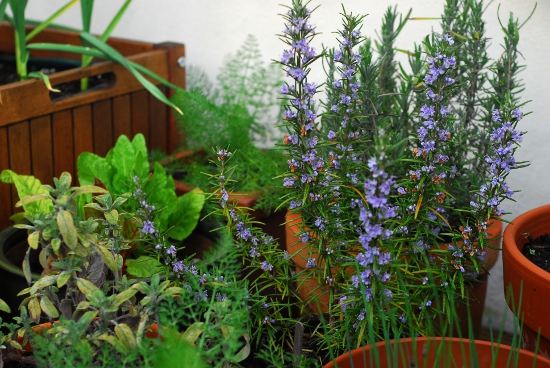
Not my best photo, but it gives at least an impression of the deep, strong colour I can see with my eyes. In the foreground, you can see the flower stalks some of the chives are sending up; and in the background the feathery foliage of one of the fennel plants.
blossom, chives, fennel, flowering, photography, rosemary
Posted in Decorative, Practicalities on Thursday, January 19th 2012 (6.08 PM).
As I mentioned our seed tin in passing the other day, I thought I might tell you a bit more about it. I asked for it on my Christmas list last year, and it comes from Ripe, a little independent homeware supplier that used to have a shop on Perry Road, but now operate from a mail-order address in Totterdown. It is, technically, a lunch tin, with cartoon hedgehogs on the side.
The Mother phoned up, after getting the list. “This tin. You do realise it’s a child’s lunch tin?” Well, yes. “You could use any old tin to keep seeds in!” I’m not sure she really understood that just having a tin wasn’t entirely the point.
seed, storage
Posted in Decorative, Photobloggery, The Old Garden In Bristol on Friday, November 18th 2011 (6.38 PM).
There haven’t, as you might have noticed, been that many posts on here in recent weeks. One reason for that, more than anything else, is the changing of the season and the changing of the timezone. When I get up in the morning, it’s dark. When I leave the house, it’s just about light – at the moment it will have been light for maybe 15 minutes, which of course will drop over the next 6 weeks. When I get home again, it’s dark, and it’s been solidly dark for well over an hour. Getting a job nearer home would help, but probably not very much, especially in the evenings.
However, there is one benefit to all this darkness. It means we can string solar-powered fairy lights all around the garden, and actually have darkness to see them in.
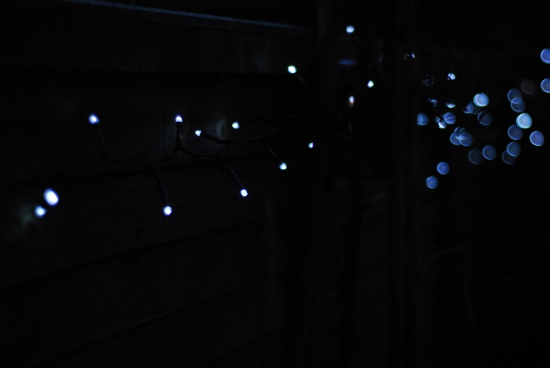
Despite the title of this post, they hardly let you garden in the dark. However, they do look good, when you look out of the kitchen windows, or stand in the middle of the garden late at night and whirl around looking at the lights and the stars.
Coincidentally, since I first drafted this entry – last week after we first put the lights up – I’ve read something else on night gardens: a post by Bristol-based gardening writer Lia Leendertz on the BBC gardening blog, about designing your garden to make it a pleasant place to spend a winter evening. Sadly we don’t have room for hedges or a fire pit, but I do like the idea of a telescope. Maybe I can make do with an SLR, my longest lens, and every teleconverter I can lay my hands on attached. Actually gardening at night will be a harder project to get going.
dark, darkness, fairy light, lighting, night, season, winter



